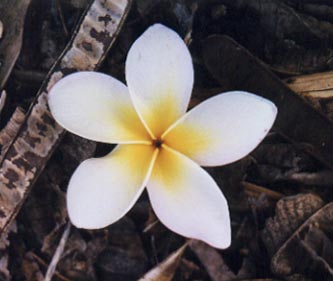
Scenic Hawaii
This page contains photos and narratives from the many scenic places of Hawaii which I have had a chance to visit, as well as some other interesting photos.
The flowers and other vegetation of Hawaii is beautiful. The plumeria, also called frangipani, is a fragrant flower often used in leis.
Maui
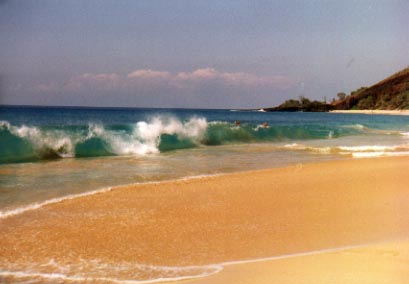
Makena is in my opinion, one of the prettiest beaches in all of Hawaii. The bright yellow sand stretches along the coast as far as you can see. The clear water breaks onto the sand in loud crashes. The beautiful lower slopes of Haleakala rises up into Maui's Upcountry region. The small islet of Molokini lies just a couple of miles offshore. And in winter, you can often spot the spout of humpback whales as they come up to breathe, sometimes only a couple of hundred yards offshore.
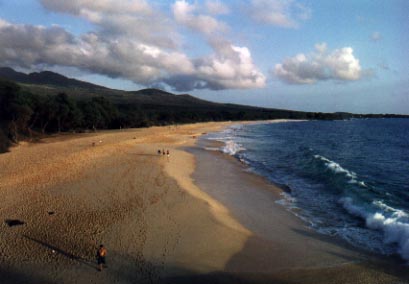
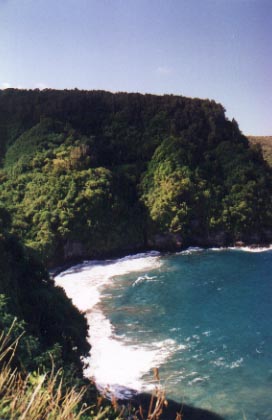
The famous Road to Hana winds along the treacherous north shore of east Maui. The road, only wide enough for one car in some places, is cut into the cliff and follows the countours of the coastline, one hairpin turn after another. Driving on this road can be dizzying and downright scary at times, but the views are just unbelievable. The photo at right shows the waves crashing in Honomanu Bay, with the lush green cliffs behind. There is a horizontal line a little more than halfway up the cliff. That is the road.

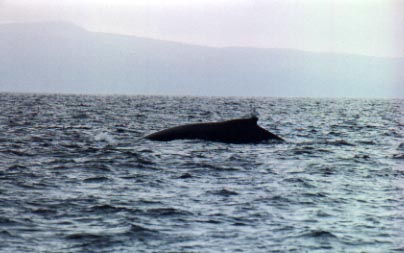
The Humpback Whales of the North Pacific also come down to Maui to vacation in winter. Actually, they use the warm shallow waters between the islands of Maui, Lanai, Molokai, and Kahoolawe as their winter breeding grounds. About half of the North Pacific population makes the annual migration from their feeding grounds in Alaska to the waters off Maui (the rest go to other locations in the South Pacific), arriving in late November, and leaving in April or May. The whales are fascinating and they are easy to see. You can often see them from shore, and if you want to get closer, there are many options for whale watching cruises. I was on a boat when I took these pictures.
One of the amazing things about Humpback Whales is that the males sing long complex songs. These songs which can last as long as 30 minutes consist of a wide range of sounds from low rumbles to high pitched squeaks. Amazingly, all of the males in a given breeding ground sing the same song. I was able to hear a singing humpback once when I was snorkeling near Black Rock in northwest Maui and it was one of the most amazing experiences of my life. Check out this site for samples of whale songs.
Big Island
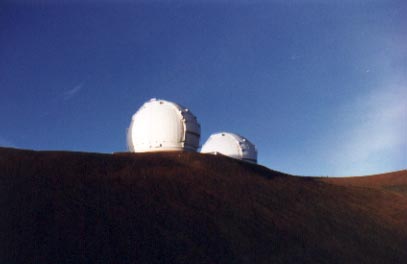
The entire family took a guided tour up to the summit of Mauna Kea. We were picked up in a van in the resort town of Waikoloa on the Kona Coast and began the three hour drive up to the summit. Waikoloa is roughly at sea level, and the summit of Mauna Kea is just shy of 14,000 feet. That is an awful lot of altitude change in three hours. We made an hour long acclimatizing stop at the visitor's center at 9000 feet, but that really isn't enough to acclimatize, as acclimatization generally takes at least one day. (Acclimatizing is the process by which the human body adapts to changes in altitude by creating more red blood cells and increasing pressure in the pulmonary arteries to accomodate for the thinner air).
We arrived at the summit with about half and hour of daylight remaining, the goal of the trip to see the sunset from the peak. As you can see from the photos, the sky was clear and the sun was shining upon our arrival to the summit. The twin domes of the Keck Observatory stand atop a knoll (above), and the collection of observatories at the summit are framed by a gray rainbow (below). However, in a matter of minutes, thick clouds moved in and we were completely socked in. Visibility was cut down to 30 feet, and in addition to the cold whipping wind, we now had horizontal rain. Needless to say, we didn't see the sunset. We did get a tour of the NASA Infrared telescope which was neat. But by this time, the altitude was catching up to me and I was getting dizzy and had a headache. So I was happy when we climbed back into the van and began our descent. We stopped in a field, at about 4000 feet above sea level, and the tour guide took out his 8-inch reflecting telescope and we explored the now clearing night sky. We were able to see the rings of Saturn, the craters of the moon, and many many stars.
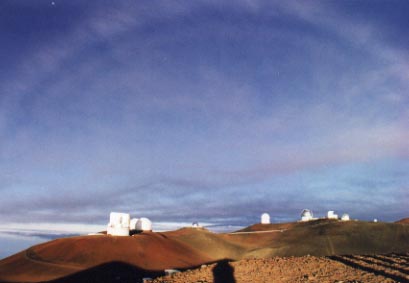
Flight over Fire - Hawaii Volcanoes National Park, Hawaii
December 1998
The Hawaiian Islands consist of extinct and active volcanoes formed as the Pacific plate moves northwest over a hot spot on the earth's crust. The youngest of the islands is the Big Island of Hawaii, which consists of four large volcanoes - Mauna Kea, Mauna Loa, Hualalai, and Kilauea. Kilauea is the world's most active volcano and has been erupting continuously for the last seventeen years. The volcanoes of the Hawaiian Islands are shield volcanoes and do not erupt explosively like Mt. St. Helens, which is a strato volcano. Instead, lava pours out of vents slowly but steadily, adding to the landmass as it flows into the Pacific Ocean and solidifies.
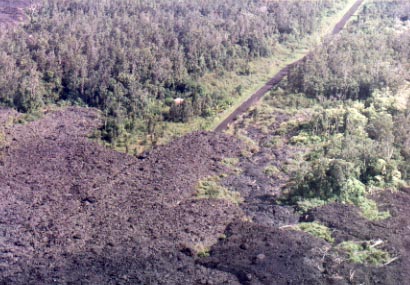
While visiting the Big Island of Hawaii, I went on a sightseeing flight over Hawaii Volcanoes National Park with Blue Hawaiian Helicopters. We boarded the six passenger, single engine Aerospatiale ASTAR at the heliport in Hilo. As we lifted off, the theme from E.T. was playing in our headsets. I watched the ground fall away below me through the window by my feet and almost felt like I was in E.T. We flew west towards the park at an altitude of about 1500 feet. From the air, the devastation that the volcano has already caused was all too apparent. We overflew the site of the million dollar National Park Service visitor center which was destroyed by a flow only a couple of years after being built. All that is left now is a few pillars of the frame. The whole coastal village of Kalapana was destroyed in 1992 by another flow. We could see the roads that used to lead into the town, now all cut off by a wall of solidified lava several feet thick. Our pilot banked the chopper to the right and we were headed straight towards a huge cone. The Pu'u O'o vent, smoking like a giant chimney, is the gateway to the earth's interior. We flew up and over the rim of the vent and we were all straining in our seats to get a good look inside the crater. The pilot made it easier for us by banking the chopper sharply and flying tight circles over the mouth of the vent. It was difficult to see through the rising vapor, but every now and again, we would get a glimpse of the lava pool. The pool of molten rock glowed like nothing I had seen before, the bright reddish orange contrasting sharply with the surrounding black rock. Following the path of the lava, we headed downhill toward the coast, flying over the extensive underground network of tunnels through which the lava flows. Contrary to what I thought, the lava does not flow over ground. When a new flow forms over ground, the part of the flow which is directly exposed to the relatively cool air, begins to solidify. The lava which is not exposed to the air continues to flow underneath it. As the top layer solidifies and turns into rock, an underground lava tube is formed. Sometimes, due to small earthquakes or other reasons, a small section of the roof of these lava tubes collapses, creating what is called a skylight (left). We overflew a few of these skylights and saw the red hot lava flowing rapidly towards the ocean. Even from a distance, we could easily see the point where the lava entered the ocean. White billowy clouds rose up into the sky as if there were a giant inferno. The result of the molten rock being rapidly cooled by the sea water and being almost instantaneously solidified is extremely violent. So much so that the explosions often send the newly formed rocks several hundred feet into the air. It is an incredible concept to be able to witness the formation of new land.
Following the path of the lava, we headed downhill toward the coast, flying over the extensive underground network of tunnels through which the lava flows. Contrary to what I thought, the lava does not flow over ground. When a new flow forms over ground, the part of the flow which is directly exposed to the relatively cool air, begins to solidify. The lava which is not exposed to the air continues to flow underneath it. As the top layer solidifies and turns into rock, an underground lava tube is formed. Sometimes, due to small earthquakes or other reasons, a small section of the roof of these lava tubes collapses, creating what is called a skylight (left). We overflew a few of these skylights and saw the red hot lava flowing rapidly towards the ocean. Even from a distance, we could easily see the point where the lava entered the ocean. White billowy clouds rose up into the sky as if there were a giant inferno. The result of the molten rock being rapidly cooled by the sea water and being almost instantaneously solidified is extremely violent. So much so that the explosions often send the newly formed rocks several hundred feet into the air. It is an incredible concept to be able to witness the formation of new land.
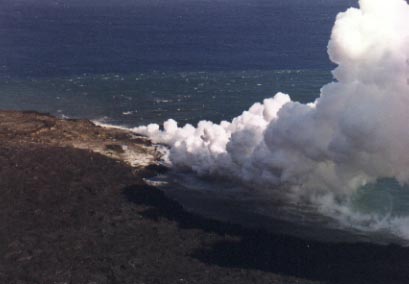
As we made our way back to Hilo, we were dumbfounded by the sight of numerous new wooden houses being built on the slopes of Kilauea, a mere three miles from the Pu'u O'o vent. Although they were being built on the eastern slopes, away from the direction of the current lava flows, one major earthquake can easily reroute the flows and destroy these houses. These new homeowners were no doubt attracted by the cheap land, but that is a risk I would definitely not choose to take.
Oahu
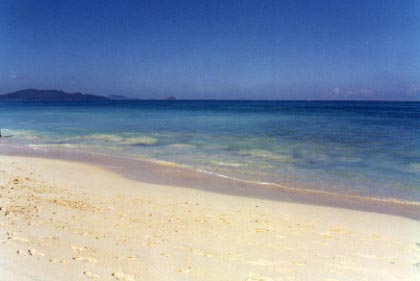
A sandy beach on the windward coast of Oahu, south of Kailua.
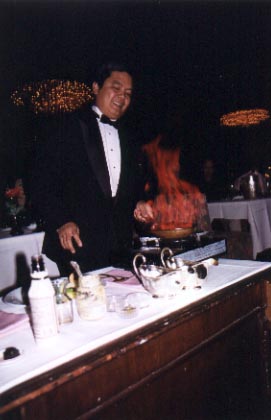
At the Sheraton Waikiki - From the top floor, there is a postcard view of Waikiki Beach, with the famous peak of Diamond Head at the end of it (below). My parents and I had really nice dinner at the Hanohano Room that night - my dad's steak being flambeed at the table (right).
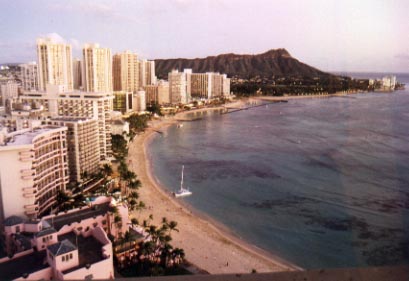
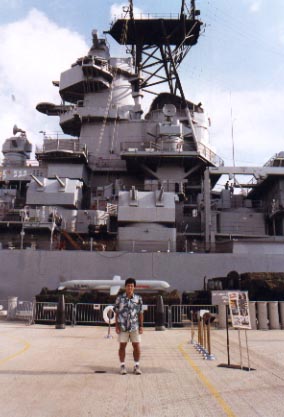
Pearl Harbor - The Arizona Memorial (below) is a pretty powerful place. To think that several hundred men lost their lives on that very spot is very subduing.
The famous battleship USS Missouri (left and far below) was decomissioned for the second and final time recently and is now a floating museum at Pearl. It saw action in World War II and as recently as the Gulf War in the early 90's.

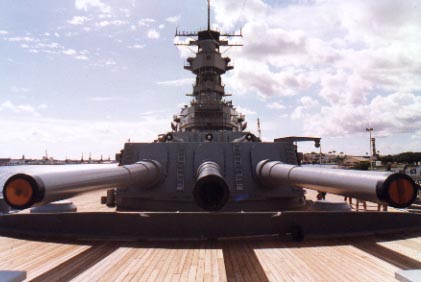
The mighty 16-inch deck guns of the Missouri.
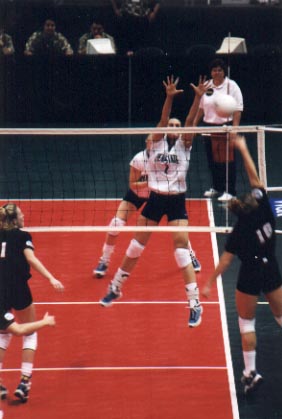
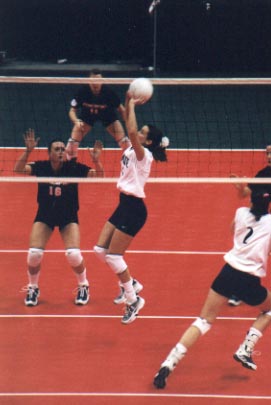
The NCAA Women's Volleyball Final Four was held in Honolulu in December of 1999 and I got to go watch my favorite team (Penn State) win their first national title. They struggled against the University of the Pacific in the semifinal, winning a nail biting five game match. But they came back and pounded a strong Stanford team in three games to win the final. Left: NCAA co-player of the year, Lauren Cacciamani sets up a solo block against Pacific. Right: All-American setter Bonnie Bremner sets Cacciamani a slide.
Back to Hawaii Page









 Following the path of the lava, we headed downhill toward the coast, flying over the extensive underground network of tunnels through which the lava flows. Contrary to what I thought, the lava does not flow over ground. When a new flow forms over ground, the part of the flow which is directly exposed to the relatively cool air, begins to solidify. The lava which is not exposed to the air continues to flow underneath it. As the top layer solidifies and turns into rock, an underground lava tube is formed. Sometimes, due to small earthquakes or other reasons, a small section of the roof of these lava tubes collapses, creating what is called a skylight (left). We overflew a few of these skylights and saw the red hot lava flowing rapidly towards the ocean. Even from a distance, we could easily see the point where the lava entered the ocean. White billowy clouds rose up into the sky as if there were a giant inferno. The result of the molten rock being rapidly cooled by the sea water and being almost instantaneously solidified is extremely violent. So much so that the explosions often send the newly formed rocks several hundred feet into the air. It is an incredible concept to be able to witness the formation of new land.
Following the path of the lava, we headed downhill toward the coast, flying over the extensive underground network of tunnels through which the lava flows. Contrary to what I thought, the lava does not flow over ground. When a new flow forms over ground, the part of the flow which is directly exposed to the relatively cool air, begins to solidify. The lava which is not exposed to the air continues to flow underneath it. As the top layer solidifies and turns into rock, an underground lava tube is formed. Sometimes, due to small earthquakes or other reasons, a small section of the roof of these lava tubes collapses, creating what is called a skylight (left). We overflew a few of these skylights and saw the red hot lava flowing rapidly towards the ocean. Even from a distance, we could easily see the point where the lava entered the ocean. White billowy clouds rose up into the sky as if there were a giant inferno. The result of the molten rock being rapidly cooled by the sea water and being almost instantaneously solidified is extremely violent. So much so that the explosions often send the newly formed rocks several hundred feet into the air. It is an incredible concept to be able to witness the formation of new land.








